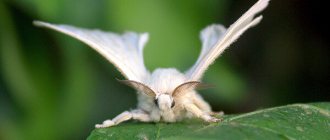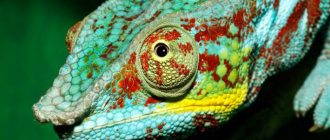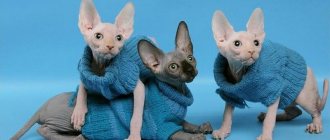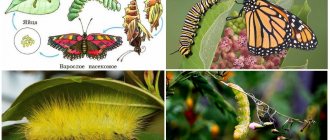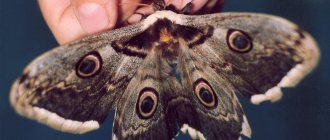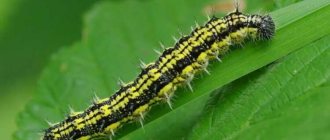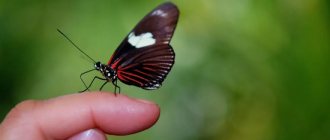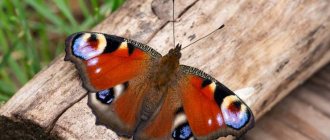The silkworm or how real silk is produced
06/13/2017 With the history of the silkworm, thanks to which such a wonderful fabric as natural silk ( lat. Mulberry)
) is associated with a huge number of ancient fictions and legends.
This material, amazing in quality, is produced by unsightly-looking caterpillars, which, eating the leaves of the mulberry tree (for us, the name mulberry is more familiar), process them, creating an amazingly thin and strong silk thread from which they weave their cocoons.
Silkworm ( lat. Bombyx mori
) is a butterfly from the insect family "
True silkworms
", and "
Bombyx mori
" literally means "death of the silkworm" or "dead silk" in Latin. This tragic name is explained by the fact that a living butterfly is deliberately not allowed to leave the cocoon, so the insect, suffocating, dies inside it (more on this sad fact below).
Cocoons can be of various colors and shades, which depends primarily on the type of silkworm, but white color is considered the highest quality, since it contains the highest percentage of silk protein.
Currently, silk production is most developed in China, Japan and India.
Adult insect
It is assumed that the silkworm moth descended from its wild relative, which previously lived in the mulberry thickets of ancient China. According to some historical data, the culture of creating silk originated about five thousand years ago, and during this time the insect was completely domesticated and even lost the ability to fly (only male insects fly during the mating period).
The silkworm butterfly is a fairly large insect with a wingspan of up to six centimeters. It is noteworthy that immediately before pupation it can increase in height to nine (!) centimeters.
Egg
Having hatched from the cocoon, the adult female mates with the male, after which she lays eggs over the course of four to six days, covering them with a dense shell called grena.
. During this period, the moth does not feed on anything, since its oral apparatus is underdeveloped.
Silkworm embryos are small and light yellow or milky in color. Having laid from three hundred to six hundred eggs (sometimes the number of eggs in the egg laying can reach eight hundred), the silkworm butterfly dies.
Larva
After about a week, a small dark brown larva emerges from the embryo (the silkworm caterpillar is often called a “ silkworm”
") about two to three millimeters long.
From birth, the larva has an excellent appetite, so it feeds around the clock, happily eating juicy mulberry leaves.
Silkworm caterpillars are very sensitive to temperature and humidity, are intolerant of pungent odors and cannot tolerate loud sounds, but if the external living conditions are quite favorable, the larvae sharply gain weight, day after day, increasing the rate of consumption of plant foods. In the rooms where silkworms are raised, there is a continuous hum from the monotonous work of many jaws, as if light rain were drumming on a metal roof.
It’s hard to imagine that these babies have more than four thousand muscles in their tiny bodies, which is eight times (!) more than a human’s.
During the growing season, the silkworm larva goes through four stages or phases of maturation, and the first molt occurs already on the fifth day from the day of birth, while the caterpillar stops feeding, and, tightly clinging to the leaf, hibernates for a day. Having woken up, the caterpillar sharply straightens its body, causing the old skin to burst and the grown insect, freed from its previous clothes, attacks the food with renewed vigor.
After four molts, the caterpillar's body increases in size by more than thirty (!) times and their body acquires a yellowish tint.
Doll
In total, the silkworm caterpillar grows and develops for about a month, and immediately before pupation the larva loses all interest in food.
Under the lower lip of the insect there are special glands capable of producing a silky gelatinous substance, which hardens into a thin silk thread.
Ninety percent of the silkworm thread consists of protein. In addition, it contains salts, fats, wax and the adhesive substance sericin.
, which prevents the threads from falling apart, tightly fastening them to each other.
When the time comes, the caterpillar attaches its body to a strong base and begins to form a frame around itself in the form of a fine mesh, and then weaves the cocoon itself, winding the thread around itself in a figure eight.
After three to four days, the cocoon is completely ready, and the total length of the thread in the finished cocoon can reach from three hundred meters to one and a half (!) kilometers.
It is noteworthy that male silkworms make cocoons more carefully, so they are somewhat denser to the touch, and the length of the silk thread in the male cocoon is longer.
After about eight to nine days, the cocoons can be collected and untwisted to obtain a thread of unique quality. If this process is delayed, then an adult insect ( imago)
) in the form of a butterfly, which will damage the shell of the cocoon and the thread will end up torn.
As mentioned earlier, the butterfly has an underdeveloped oral apparatus, therefore it is not able to gnaw through the shell of the cocoon and, in order to fly out, it secretes a special substance with saliva that dissolves the upper part of the cocoon, damaging the threads. To avoid this, butterflies are artificially killed directly in cocoons using hot air, treating the pupae for two hours. This process kills the butterfly, so that the name of this insect species (" Death of the Silkworm"
") completely justifies itself.
After unwinding the thread, the dead pupa is eaten (usually in China and Korea) as it is rich in protein and nutrients.
The process of creating silk thread
Currently, silkworms are mainly raised artificially.
The cocoons are collected, sorted by color, size and prepared for subsequent unwinding, for which they are dipped into boiling water. This process is still done by hand, since the cocoon thread is very thin and requires special care to unwind it.
To create a raw thread, when unwinding, from three to ten silk threads are connected together, and the same natural sericin
helps to carefully tie all the ends together.
Raw silk is wound into yarn and sent to a weaving factory for further processing and production of a wonderful fabric that is highly valued throughout the world.
Legend has it that the first person who came up with the idea of weaving yarn from silk thread was the legendary Chinese Empress Lei Zu (also known as Xi Lingshi), walking through a mulberry garden with a cup of hot tea, into which a silkworm cocoon suddenly fell. Trying to get it, the empress pulled a thin thread, causing the cocoon to unwind.
Lei Zu convinced her husband (the legendary ruler of China Huang Di or the “ Yellow Emperor”
") to provide her with a grove of mulberry trees where she could breed caterpillars that produce cocoons. She is also credited with the invention of a special spool that combines thin threads into one strong thread suitable for weaving, and the invention of the silk loom.
In modern China, Lei Zu is an object of worship and bears the honorary title “ Mother of the Silkworm.”
».
Share on social networks:
Silkworm - Bombyx mori.
Silkworm - Bombyx mori. With their slow painful death and loss of the ability to fly, tiny grayish-white silkworm butterflies paid for our right to soar and flutter in beautiful silk dresses. Actually, in Latin, Bombyx mori means “death of the silkworm” or “dead silk.” Nature is wonderful, but man is ruthless. Sirye Kiin
The silkworm is a pet in the full sense of the word. Wild species of this butterfly are no longer found in nature.
From century to century, people selected cocoons with the best shell for the tribe, increasing their silk production. Now the weight of the silk shell is approximately half the weight of the dry cocoon. Many breeds of silkworms have been bred by artificial selection, differing in silk productivity, morphological and physiological characteristics. In modern sericulture, silkworm hybrids are used, which, compared to pure breeds, give a higher yield of cocoons, with greater silk production and better technological qualities of cocoon threads. . A butterfly that laid a bowel. Photo Silkworm caterpillars hatch from eggs (greens) at a temperature of 23–25°C. It takes 8–10 days for the eggs to develop, after which small larvae, only about 3 mm long, are born. They are dark brown in color and covered with tufts of long hair. Silkworm larvae feed exclusively on mulberry leaves; they eat leaves non-stop, day and night, which is why they grow very quickly. The larvae eat mulberry leaves with such appetite that the famous French scientist Pasteur compared the loud crunching sound coming from the food shelf with “the sound of rain falling on trees during a thunderstorm.” By the way, it was Pasteur who proposed a way to combat the most dangerous silkworm disease - pebrina.
The caterpillars grow very quickly, but their skin does not grow. Gradually its smallest folds straighten out, the skin stretches and begins to shine, it becomes tight. The caterpillar stops eating and freezes until a new one forms under the old skin. After about a day, the larva straightens strongly, the old skin bursts, and the caterpillar, grown and covered with delicate new skin, crawls out of its tight clothes. Then she rests for several hours and then starts eating again. Four days later, the caterpillar falls asleep again before the next molt.
Stages of development of the silkworm. Drawing During its life, a silkworm caterpillar molts 4 times. After the fourth molt, the caterpillar already looks very impressive: its body length is about 8 cm, thickness is about 1 cm, and weight is 3–5 g. Her body is now almost naked and painted whitish, pearl or ivory. But the main thing is a small tubercle under the lower lip, from which a sticky substance oozes, which, upon contact with air, immediately hardens and turns into a silk thread.
Even the smallest caterpillar that has just emerged from an egg can already secrete a thin thread. Whenever the baby is in danger of falling down, she releases the silk and hangs on it, like a spider hangs on its web. But after the fourth molt, the silk-secreting glands reach especially large sizes - about 40% of the caterpillar’s mass.
Now every day the caterpillar eats less and less and finally stops eating altogether. At this time, the mulberry gland is already so filled with liquid that a long thread trails behind the larva, wherever it crawls. The caterpillar, ready for pupation, crawls restlessly in search of a suitable place for pupation.
Having found a suitable support, the caterpillar quickly crawls onto it, clings tightly with its legs, and immediately begins its work. She throws her head now to the right, now back, now to the left and applies her lower lip with a “silk” papilla to various places in the cocoon. Soon a rather dense network of silk thread forms around it. But this is only the basis - the frame of the cocoon. Having finished with the frame, the caterpillar crawls to its center - at this time, silk threads support it in the air and serve as the place where the real cocoon will be attached. And so his curling begins. As the caterpillar releases the thread, it quickly turns its head. Each turn requires 4cm of silk thread, and the entire cocoon takes from 800m to 3km! The caterpillar must shake its head tens of thousands of times to spin a cocoon. It takes about 4 days to make a cocoon. Having finished its work, the exhausted caterpillar falls asleep in its silk cradle and turns into a chrysalis there.
Some caterpillars, they are called carpet makers, do not make cocoons, but, crawling back and forth, line the surface of the food shelf as if with a carpet, while their pupa remains naked. Others, lovers of joint buildings, unite in twos or even threes and fours and weave a single, very large, up to 7cm, cocoon. But these are all deviations from the norm. And usually caterpillars weave a single cocoon, the weight of which, together with the pupa, is from 1 to 4 g.
Silkworm cocoon in section. Figure Cocoons produced by spinner caterpillars are very diverse in shape, size, and color. Some of them are completely round, others have an oval shape with a sharp end or a constriction in the middle. The smallest cocoons do not exceed 1.5–2 cm in length, and the largest reach 5–6 cm. Interestingly, male cocoons contain 20% more silk than female cocoons
After about 20 days, the pupa turns into a butterfly, which is faced with the problem of how to get out of its silken shelter. To do this, the butterfly has alkaline saliva, which softens the wall of the cocoon. Then the butterfly presses its head against the weakened wall, energetically helps itself with its legs, and finally climbs out.
The silkworm butterfly is inconspicuous; the color of its plump, hairy body is white with a light cream pattern, or dark grayish-brown. The wingspan of the silkworm is about 4.5 cm, but these butterflies cannot fly. They have lost this ability through the process of constant human selection. After all, sericulture does not need individuals that can fly away?
Domestic butterflies generally do not tend to bother themselves with unnecessary movements. They only move slowly on their thin legs and move their shaggy antennae. During their short (about 12 days) life, they do not even feed. After alkaline saliva is released from their mouth, softening the cocoon, the mouth closes forever.
Male silkworms change their behavior only when they meet individuals of the opposite sex. That’s when they become animated, circling around their friend, constantly flapping their wings and actively moving their legs. During the mating season, the silkworm puts pairs of butterflies in special gauze bags. A few hours after mating, the female begins to lay eggs from 300 to 800 pieces. This process takes her 5–6 days. Silkworm eggs are very small, there are approximately 1,500 of them in one gram. 10-20 days after laying, the butterflies die.
But not every caterpillar that weaves a cocoon is given the opportunity to turn into a butterfly and live its 20 days. Most of the cocoons are used to obtain raw silk.
To get 1 kg of raw silk, you need about a thousand caterpillars, which eat 60 kg of mulberry leaves in a month and a half - that’s three mulberry trees!
